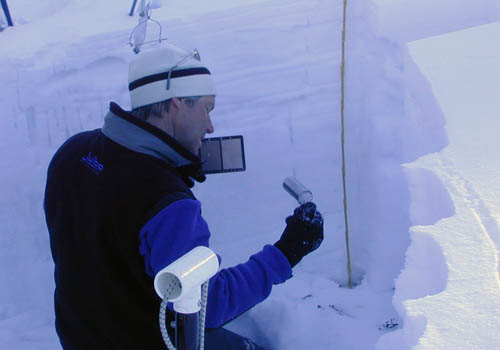Avalanche Avoidance – Salvation Through Education

- Pitting out. Like a college degree, the actual information you learn in an avalanche class is secondary to learning the terms and methodology.
Avalanche education has a constantly changing curriculum that is worth keeping up on. It is important to get in the habit of continuing education with avalanches, and the pros do it all the time through seminars, meetings and trade journals.
More than anything, classes force you to think about avalanches, practice safe skiing, familiarize yourself with your beacon and look critically at snow. Plus, they are often good places to meet partners with similar levels of enthusiasm and skills.
Avalanche education also helps to develop your vocabulary, which in turn is useful for deciphering avalanche forecast reports. Learning that a “westerly front produced significant cross-loading on mid elevation ridgelines” doesn’t help you much if you have no idea what they are talking about!
______________________
For 15% off on a Black FlickLock Snow Saw from Backcountry.com, click the photo below…
Category: 07 Avalanche Avoidance










Andrew,
I like your comments about continuing avalanche education.
But, I think it should also be said that folks need to practice their avalanche skills. Mainly their transceiver skills.
I think too many folks buy a transceiver and practice once or twice with it and then think that they are well versed in how to use it. As we all know when the poop hits the fan panic sets in. and that’s when people wish that they had practiced more with their transceiver….
I like to suggest that folks do at least 2 if not 3 practice sessions a month starting just before winter arrives. And duing each session try doing 3 single burial and 3 multiple burial practices. You can do these practices in less (I hope less) then an hour.
Cheers,
Halsted
Thanks for the comments Halsted.
For me, and probably a lot of other people as well, practicing with a beacon on a powder day seems like an inconvenience, but I’m always glad I did it in retrospect and think “I should do that more often.”
I like setting up practice searches when/if you get to the top of a climb ahead of others. This kind of simulates the confusion associated with a real search – people are tired, in different states of gear disarray and nobody has any advance warning.
I’m a fan of the new generation of digital beacons, but at the same time, they are so fast and accurate that after a practice session or two, you get lulled into thinking they are infallible, which they aren’t. I had a beacon once which could find other beacons and passed the basic walk-by check, but for some reason the signal was off and it was impossible to locate in a fine search. I have no idea how many days I skied with it like that!
Oh, that’s scary….. How did you discover the problem?
One thing that I found is that most folks ware their transceivers on there side. Which for a lot of transceivers means the transmitting antenna is in a vertical orientation when the victim is buried. Because, (I don’t have the figures at hand)at least 60% of all burials are face-up or face-down.
So, when you searching for buried victims a lot of times their transciver is buried in a vertical orientation, which is the hardest orientation to find with all transceivers. It would be best if we all practiced more and did a lot more vertical orientation burial practices…
Cheers,
HM
I discovered the malfunction when I buried my beacon and nobody, including me (who knew exactly where it was) could find it. The signal would get close, then erratically shift.